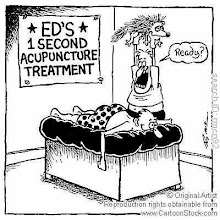RACHIALGIA
Pain in the vertebral column.
RACHICENTESIS
Lumbar puncture for examination of the spinal fluid; rachiocentesis.
RACHIOCAMPSIS
Curvature of the spine.
RACHIOCHYSIS
Effusion of fluid within the vertebral canal.
RACHIOKYPHOSIS
Humpbacked curvature of spine; kyphosis.
RACHIOMYELITIS
Inflammation of the spinal cord.
RACHIOPARALYSIS
Paralysis of the spinal muscles.
RACHIOPATHY
Any disease of the spine.
RACHIOPLEGIA
Spinal paralysis.
RACHIOSCOLIOSIS
Lateral curvature of the spine.
RACHIOTOMY
Incision into a vertebral canal for exploration.
RACHISAGRA
Pain or gout in the spine.
RACHISCHISIS
Abnormal congenital opening of the vertebral column.
RACHITOMY
Surgical or anatomic opening of the vertebral canal.
RADICULECTOMY
Excision of a rootlet or resection of spinal nerve roots.
RADICULOPATHY
Disease of the nerve roots in or near the spinal canal as a result of direct pressure from a disc, or inflammation of the nerve roots due to disc or spinal joint disease.
RADIATION ONCOLOGIST
A medical doctor who has received advanced training in the treatment of persons receiving x-ray treatment for an illness.
RADIATION PHYSICIST
A person having a PhD degree who is trained in the science dealing with the properties, changes and interactions of continous energy.
RADICLE
A rootlet or structure resembling one, a minute veinlet joining with others to form a vein.
RADICULAR
Relating to the radicle.
RADIOLOGIST
A medical doctor who has received specialized training in interpreting x-rays, CTs, MRIs and performing angiography.
RADIOTHERAPY
Treatment of a lesion with radiation.
RADIUS
The lateral and shorter of the two bones of the foreman.
RECOMBINANT HUMAN PROTEINS
proteins developed by isolating a human protein and using recombinant DNA technology to produce genetically engineered proteins that act like natural proteins.
REFERRED PAIN
Sclerotomic in distribution and felt distant from its origin (e.g., bursitis in the shoulder produces pain in the lateral arm, and sciatic-like leg pain can be referred from the lower-back area).
REFLEX
An involuntary reaction in response to a stimulus applied to the periphery and transmitted to the nervous centers in the brain or spinal cord.
RESECTION
The surgical removal of part of a structure, such as bone.
RESORPTION
The removal of bone tissue by normal physiological process or as part of a pathological process such as an infection.
RETROLISTHESIS
Posterior displacement of the vertebra on the one below.
REVERSAL of CERVICAL LORDOSIS
Change in the normal curvature of the cervical spine as seen on lateral radiograph. This is usually a straightening of the normal lordotic curve or an actual reversal
and is most commonly caused by muscle spasm, indicating cervical disc abnormality.
RHEUMATOID ARTHRITIS
Generalized inflammatory joint disease.
RHIZOTOMY
Division of the roots of the spinal nerves.
RISSER
For scoliosis deformity; particular attention to fusion of facet joints and use of cast stabilization.
ROAF, KIRKALDY-WILLIS, and CATTERO
Drainage of thoracic spinal abcess through dorsolateral approach.
ROBINSON and RILEY
An extensive anterior approach for fusion of C-1 to C-3 or lower.
ROD
In spinal applications, a slender, metal implant which is used to immobilize and align the spine.
ROGER FUSION
Posterior cervical using iliac cortical and cancellous grafts.
ROGOZINSKI
A combined anteroposterior device used in correction of spinal deformities.
ROOT
The primary or beginning point of any part, as of a nerve at its origin from the brainstem or spinal cord.
ROOT SLEEVE FIBROSIS
Scar tissue surrounding a nerve in the spinal canal or neural foramen; epineural fibrosis. If it is within the nerve, it is called intraneural fibrosis.
ROUNDING OF THE CRANIAL BORDER
Relationship of the height to the width of the rounded portion of the superior sacrum.
ROY-CAMILLE
For stabilization between the skull and C-2; posterior bone graft with wire and parallel vertical screw plate fixation from occiput to C-3. Posterior pedicle screw and plate device for spinal stabilization.
RUDIMENTARY RIBS
Nubbins of ribs seen below the level where the last rib normally occurs.
RUPTURED DISC
See Herniated Disc.
Sunday, March 8, 2009
Subscribe to:
Post Comments (Atom)



No comments:
Post a Comment